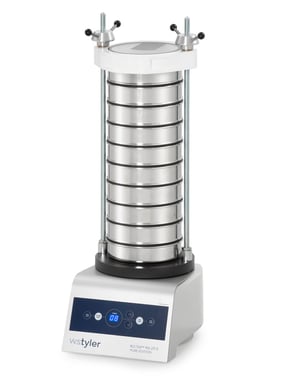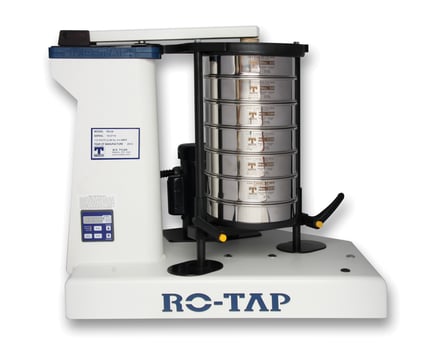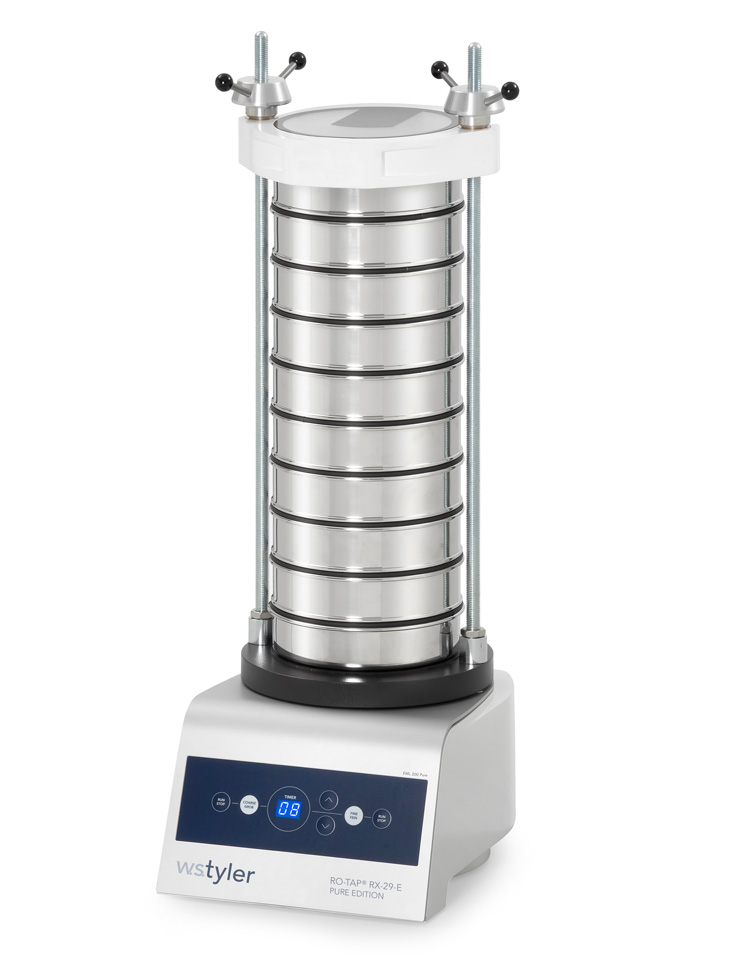Electromagnetic vs Mechanical Sieve Shakers (With Video)
When purchasing a sieve shaker we often hear the question, “What is the difference between an electromagnetic sieve shaker and a mechanical one?”
We sell both of these types of shakers, so we have a pretty good understanding of the two. The truth is, there aren’t any differences in results or capabilities.


Electromagnetic Sieve Shaker Mechanical Sieve Shaker
When it comes to choosing the right machine for your particle size testing, you should review the various features of the different models. The size of the machine, the separation action, and the noise level are all things to consider.
As far as functionality goes, electromagnetic and mechanical shakers perform the same particle analysis and yield the same consistent results.
You can think of the electromagnetic sieve shaker as the revamped version of the mechanical sieve shaker. It’s more technology-driven and hasn’t been around nearly as long as the original RO-TAP® which has been around for over 100 years.
We are going to take a look at both electromagnetic and mechanical sieve shakers in the following areas:
- Range of models
- Noise
- Footprint
- Ease of Use
- Possibility of Errors
- Maintenance
- Cost- Particle Size Range
Range of Models
Mechanical Sieve Shaker
There are 3 different types of mechanical sieve shakers that we offer. The RX-29/RX-30 single stack tapping machines for 8 and 12-inch sieves, the RX-812 oscillating shaker, and the RX-94, a double-stack tapping machine for 8” sieves. To learn more about each type of sieve shaker you can check out our article: What is a RO-TAP® Sieve Shaker?
Electromagnetic Sieve Shaker
There are three different types of electromagnetic sieve shakers.
RO-TAP® Electromagnetic E Pure: 3D sieving motion created by an electromagnetic drive. Offers two settings for sieving- coarse and fine
RO-TAP® Electromagnetic E Premium: Offers the customer the ability to adjust the amplitude and intervals on the sieving actions. These settings will change the intensity of shaking and how often the machine pauses. You can create saved presets including run times for your different particle analysis samples.
RO-TAP® Electromagnetic E Premium Remote: Includes all of the features of the E Premium and includes the option for wet sieving.
Noise
Mechanical Sieve Shaker
We have talked a lot about the noise level of our most popular RO-TAP model’s noise level. We see the noise level of the mechanical units being an issue for some people but completely fine for others.
The mechanical RO-TAP models use a tapping and rotating motion to separate particles.
For customers working in very small labs where there are lots of people around, the 85 dB noise level caused in part by the tapping motion, may be a concern in these situations.
We do offer a sound enclosure cabinet you can purchase, which reduces the noise level to 78dB.
We are looking at the mechanical units versus the electromagnetic units for this article, and in this case, the electromagnetic units are much quieter than the mechanical.
Electromagnetic Sieve Shaker
One of the benefits of electromagnetic shakers is they are not as loud as the mechanical units. The electromagnetic units use a vibrating motion to shake particles down through the sieve stack instead of the tapping and gears on the mechanical units.
The electromagnetic units all operate at a noise level that is less than 70 dbs.
Footprint
Mechanical Sieve Shaker
The footprint of the mechanical units is larger than the electromagnetic units. The RO-TAP sieve shaker model RX-29, our most popular unit, measures 28” wide x 21" deep x 25” high and weighs 170 lbs. The footprint increases in size when the sound enclosure cabinet is being used as well.
Electromagnetic Units
These units are smaller than the mechanical units. They do not take up as much counter space.
Electromagnetic units measure about 14” wide x 12” deep x 37” high and weigh 80 pounds.
Ease of Use
Mechanical Sieve Shaker
These units are easy to use. Once you have chosen the correct test sieves for your process, it is as simple as turning on the machine and setting the test time. You just plug them in and press start. Once the test has been run, it is up to you to perform your sieve analysis. You should run an end of sieving analysis to determine how long you should be running your sieve analysis. Our engineer has broken down how to perform this analysis in our article: How Long Do I Run My Sieve Shaker for (End of Sieving Analysis).
Electromagnetic Machine
These units are not difficult to use, but they are more complicated than mechanical shakers.
The RO-TAP E Premium model allows you to customize the way the shaker separates your particles by adjusting the amplitude and the interval at which the motion pauses to allow the particles to fall through the mesh.
The Premium units can also store Standard Operating Procedures, using the amplitude and intervals of your choosing, for different materials you are processing. This allows you to skip the manual set up during each test and just choose the right presetting.
Possibility of Error
For both types of machines, mechanical and electromagnetic, the possibility of error is the same. The machine itself will yield consistent results..Human error is the number one thing affecting the results of your sieve analysis.
It is important to be sure you are performing a thorough and consistent analysis to yield consistent and accurate results.
Particle Size range
As far as the size of particles that each machine can analyze, the range is the same for both. The particle size is determined by the test sieves that the machine uses, which is up to you and your processes for each. Typical sieve mesh sizes range from 4” down through 20um.
Cost
Mechanical Sieve Shaker
Mechanical sieve shakers are going to cost anywhere from $1,975.28 to $6,230.07. After using these units for a year or so, you will also need to factor in some costs for parts and maintenance as well. This is normal as there are “wear” parts which are easy to replace.
Electromagnetic Sieve Shakers
These types of sieve shakers can range from $6,585.52 to $11,005.80. You can expect to pay less for these units in terms of maintenance, as there are not as many “wear” parts. These units are slightly more costly due to the technological differences in the machine's operations
For more information on the cost of each machine you can check out our article: How Much Does a RO-TAP® Sieve Shaker cost?
Maintenance
Mechanical Sieve Shakers
Mechanical Sieve Shakers are made up of over 60 different parts. These parts all work together to give the shaker the movement it needs to separate the particles down through the sieve stack.
Like we said earlier in the cost section, a new machine shouldn’t need any maintenance during the first year. We do find that after about a year of consistent use, some of the parts will suffer some wear and tear and may need to be replaced.
The parts on the RO-TAP are all available for individual purchase and are not difficult to replace. We also offer maintenance kits, which includes some of the most replaced parts. Our customer service team offers support to help through this process if need be.
Electromagnetic Sieve Shakers
When it comes to electromagnetic sieve shakers, they are built more technology-driven rather than gear driven. They have less moving parts.
We hardly ever experience customers who use these electromagnetic sieve shakers having maintenance issues. If you would have one, it would cost more to fix or replace because this machine is technology-driven. But, we do not see the maintenance issue very often with these units.
To Sum It Up
We hope this article helped you understand the differences between the mechanical sieve shakers we offer and the electromagnetic ones.
There is a difference between the capabilities, but the functionality and performance of the machines is the same.
If you are choosing between the two, you should think about the size of your lab and what model suits your situation best. You can also think about your price range to help you make your decision.
Regardless of which machine you choose, you will get consistent particle analysis results from both machines.
If you need more information about shakers or choosing your test sieves you can contact us and we will be happy to talk with you.
Want all the latest industry trends and innovations sent directly to your inbox? Subscribe to our monthly newsletters today!




